Tutorial: Visual Analysis and Historical Source Criticism of Desmet’s Film Posters and Business Documents
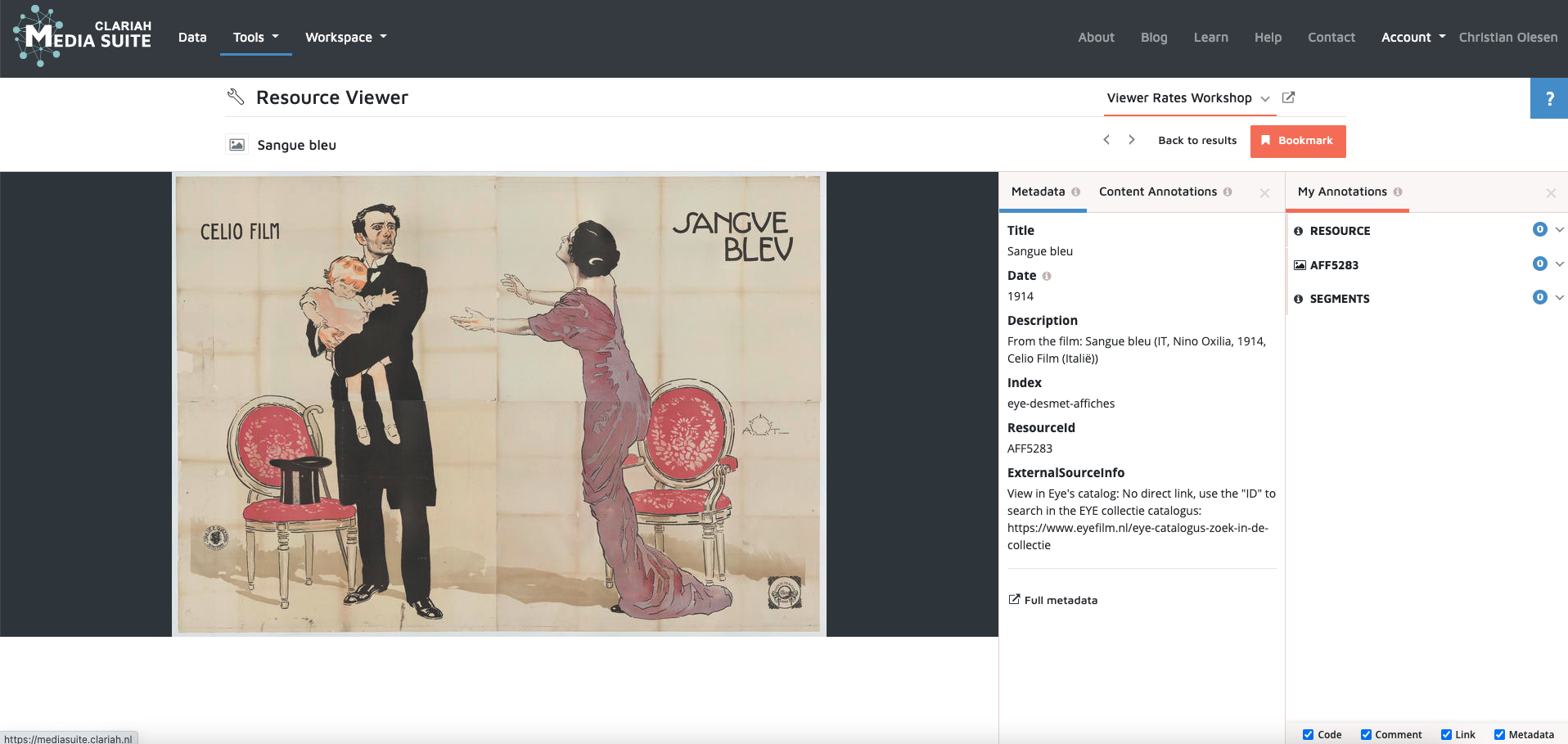
Tutorial for CLARIAH Media Suite V 5.3, May 2021
Tutorial Description, Case and Objectives
In this tutorial you will learn how to carry out a source critical analysis of items in and relating to Eye Filmmuseum’s Jean Desmet Film, Poster and Paper Collections. To this end, you will be using the Media Suite’s Search, Segmentation and Annotation features. Working on both internal and external source critical levels, this comprises carrying out a visual analysis of a historical film poster, and contextualizing its distribution and use in the promotion of a film based on business documents and contemporary film journals. In order to achieve this, this tutorial teaches you to make an overall (visual) analysis of film posters and business documents by singling out and commenting on graphic and text elements using the Media Suite’s image annotation functionalities. Moreover, you will learn to contextualize a poster’s visual discourse and role in film distribution based on historical business documents and journals using the Media Suite’s bookmarking and linking functionalities. Finally, you will learn to use annotations for supporting and substantiating your observations, including a rationale of how you arrived at choosing certain parts of a poster and relating them to specific documents or journals, while discussing potential relevant research problems. To sum up, after completing this tutorial, you will be able to use the Media Suite for carrying out a source critical media historical analysis by:
-
Building a corpus consisting of one or more posters and business documents from Eye Filmmuseum embedded in the Media Suite as well as digitized resources made available via Eye’s library
-
Creating an image segmentation using the Media Suite segmentation and annotation functionalities
-
Annotating image items on item and segment levels in order to add your own comments and rationale and to include links to items outside of the Media Suite
For the tutorial you will be working primarily with materials relating to the Italian diva film Sangue Bleu (1914) - in Dutch De Vorstin - directed by Nino Oxilia and starring Francesca Bertini. This film’s poster and promotional materials is in many ways typical of film promotion at the time insofar as it reflects how various promotion strategies were being established in this period. Moreover, both the film, poster and business documents relating to the film have been preserved and can all be accessed via the Media Suite. This makes it an easy case study to begin with because there is a lot of available material to work with.
Types and levels of teaching and research
This tutorial is intended for film and media students at BA level that are familiarizing themselves with media historical research methods and digital collections, and who are learning principles of source criticism in this process. The tutorial may support both film historical teaching - in particular teaching on film distribution and promotion, early film culture’s development and business practices - as well as teaching on media historical research methodology more broadly.
Prerequisites
Conceptually, it is a prerequisite for this tutorial that you are familiar with basic principles of historical source criticism, in particular the distinction between external and internal source criticism. On a technical level a familiarity with the most basic functionalities of the Media Suite is also required, such as being able to log in, creating a user project and being familiar with the Media Suite’s Workspace. Most of these steps will also be explained in this tutorial, but if you wish to explore these features before following this tutorial, you may consult a quick guide here . Furthermore, it is also good to have familiarized yourself a bit with the life and work of Jean Desmet and the preservation of his personal collections and archives at the Eye Filmmuseum. For an introduction to Jean Desmet we refer to Ivo Blom’s extensive research on the Desmet Collection, in particular his dissertation Pionierswerk. Jean Desmet en de vroege Nederlandse filmhandel en bioscoopexploitatie (1907-1916) (2000, available for download here ), and the later monograph in English based on this dissertation - Jean Desmet and the Early Dutch Film Trade (2003) - available for open access download here . Knowledge of Dutch is of course also necessary as most of the sources in this tutorial are in Dutch, if you are following this tutorial as part of a class taught in English and Dutch is not your first language, you may want to team up with a Dutch-speaking person.
Acknowledgements
This tutorial has benefitted from and drawn on the input and assignments developed by Utrecht University’s Film Studies team in the BA courses *Introduction to Film Studies *and Geschiedenis van het medialandschap . The tutorial authors would like to thank Dr. André van der Velden for his feedback on an early version of this tutorial.
Steps
1. Accessing the Media Suite**
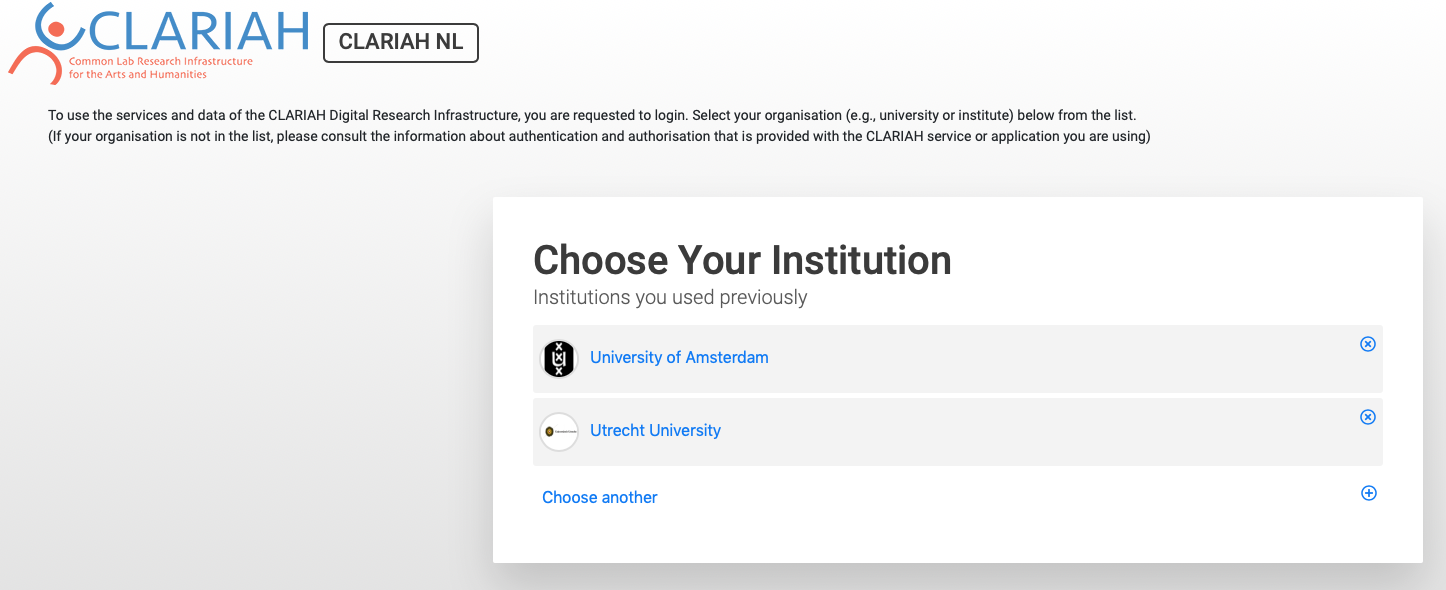
-
Before you can begin searching and bookmarking items in the Media Suite you need to log in using your university login credentials. In order to do so, go to mediasuite.clariah.nl
-
Click on the “Log in” button (top right of the page)
-
In the SURFConext interface, search for the name of your institution, or scroll through the list
-
Select your institution and use your institutional credentials to log in (university student or employee ID), and wait until the service connects ( NB when logging in the first time, you will have to accept Terms of Use and Privacy)
-
You will now enter the Media Suite workspace
2. Create a User Project
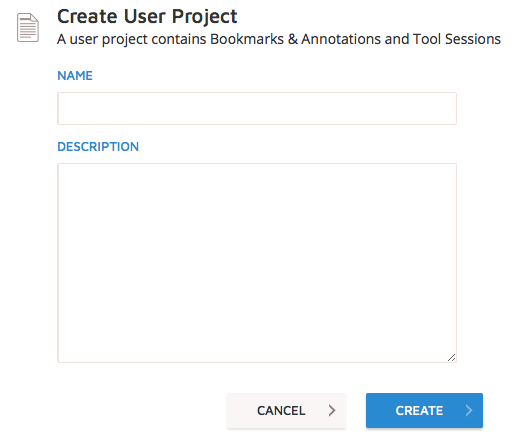
-
After having logged in, you need to create a user project. In order to do so, hover over the “Workspace” tab. From the drop-down menu, choose “Create User Project”
-
Name your project and add a project description. As you will be working on analyzing promotional materials for Sangue Bleu (1914) *in a source critical perspective in this tutorial, you may for instance call the project “Source Criticism Sangue Bleu ” and add a description that describes your project’s aims
-
Click the “Create” button to confirm
3. Find, select and bookmark a poster with Search tool Desmet Poster Collection
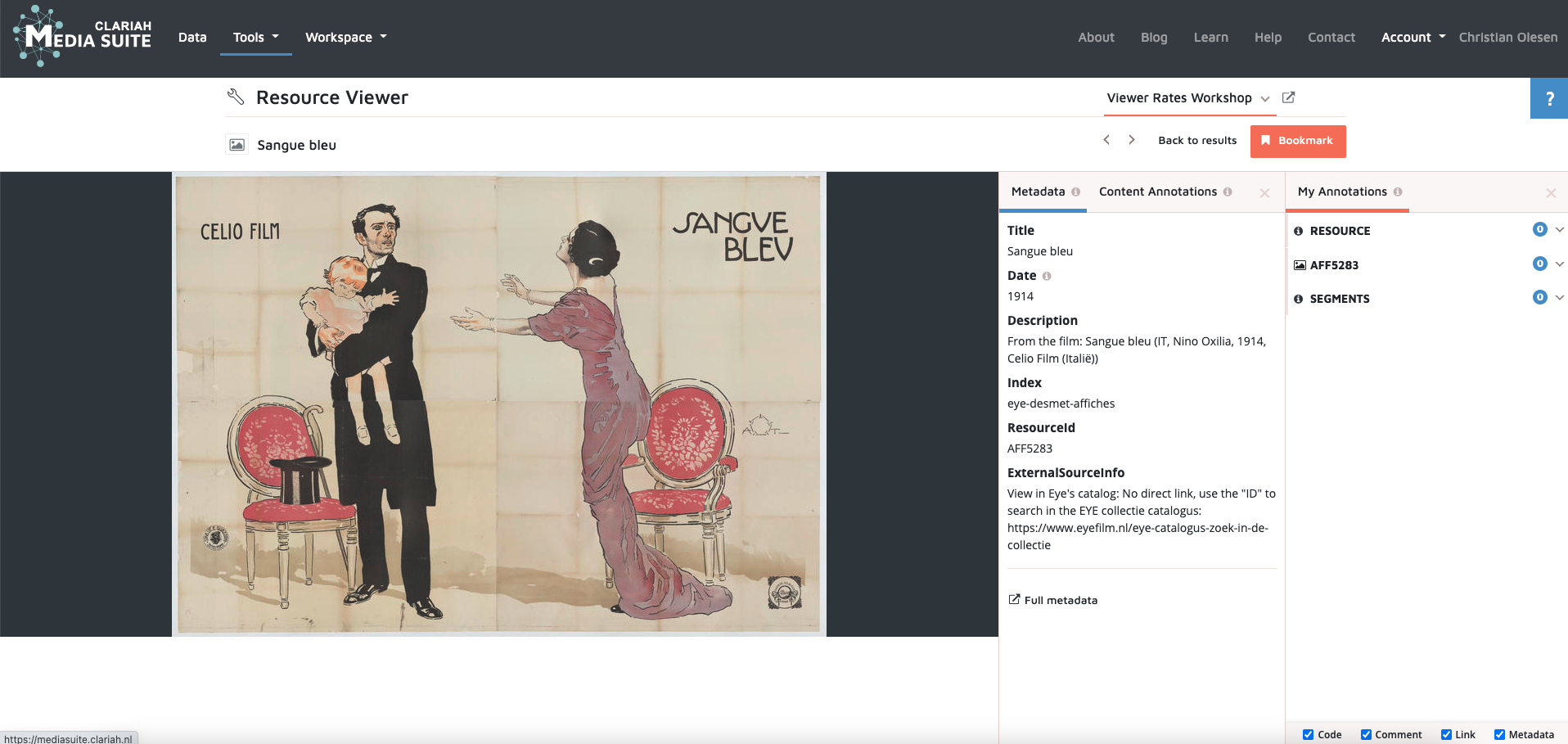
Before you can begin your source critical analysis of the poster for Sangue Bleu , you first need to find the poster and enter it into your corpus. In order to do so take the following steps:
-
Hover over “Tools” tab and select “Search” from the drop-down menu
-
Make sure to set active project in the upper left corner and choose the project you just created
-
Subsequently, click “Select Collection” in the upper left corner and then select “Desmet Poster Collection” from the drop-down menu
-
Once you have selected the collection you can begin searching in it. Search for “Sangue Bleu”. This should result in three exact title matches in the results overview. Click on the items in the list to check which is the most relevant.
-
You may realize that only one of the items can be viewed - the item with the resource ID “AFF5383”. This is the item we will be working with for our visual analysis. Click on the item in order to view it in the resource viewer (see an example of what the interface should look like after having clicked).
-
In order to be able to annotate this item for analytical purposes you need to bookmark it in the viewer. By bookmarking the item, you enter it into your user project’s corpus and will subsequently be able to annotate the item. To do so click “Bookmark” in the upper right part of the screen above the video player. The bookmark window opens.
-
In the bookmark window, add the poster to a bookmark group. If necessary, create a bookmark group, for instance “Poster” or “Promotional materials”
4. Annotating reflections external source criticism of poster
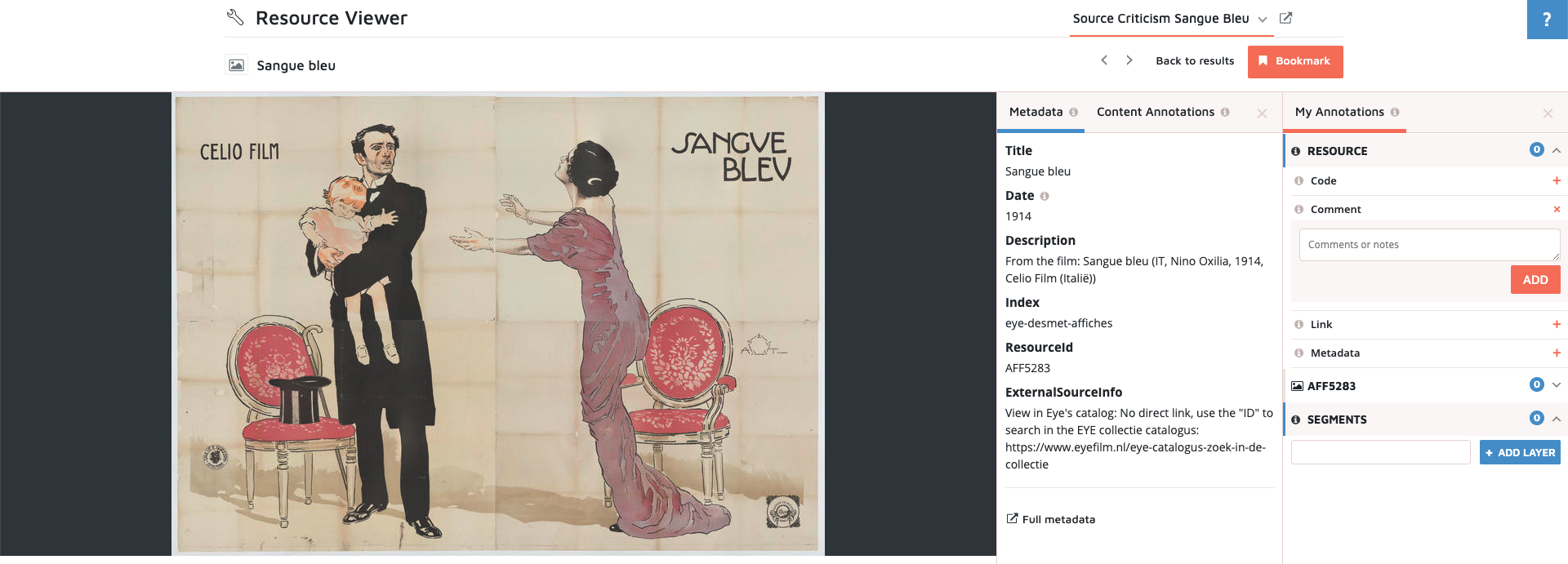
Having entered the poster into your corpus, you may now begin to add annotations to it as a way to write down source critical reflections and observations regarding its external features. When we do external source criticism we look at the basic features of the source so as to evaluate its authenticity and credibility. Questions pertaining to external source criticism might be: What type of source are we dealing with? What was the original function of the source? What implications do the type and function of the source have for the nature of the information we may gain from it, and for the reliability of the information? In this part you will be annotating the poster by following the steps below as a way to save your reflections on these questions while consulting it in the Media Suite:
-
In the Media Suite, you can annotate items on both item level and on segment level. By annotating on item level you add an annotation relating to the whole item. By annotating on segment level you add an annotation to a specific selection of that item. In this part we will be annotating on item level (for posters this is the only option possible).
-
In order to annotate on item level, go to the “My Annotations” bar on the right-hand side of the screen and click on “RESOURCE”.
-
Clicking on “RESOURCE” opens a drop-down menu with four options: “Code”, “Comment”, “Link” and “Metadata” (see the image above for an example):
-
“Code” allows you to label the item using terms from existing thesauri (such as GTAA and UNESCO) or using your own custom-made taxonomy
-
“Comment” gives you the possibility to enter your own comments about the item without a set word limit (even though the “Comment” text field seems small it has no upper word limit)
-
“Link” allows you to include links to items in the Media Suite or outside of it
-
“Metadata” allows you to devise your own metadata scheme for the item.
-
-
For the purpose of an external source criticism of a film poster, we suggest using the “Comment” annotation functionality as it allows you to comment freely on the item. In order to add a comment simply start typing in the comment field and save the comment by clicking “ADD”
-
Now it is time to annotate. In your comments you may reflect on the aspects of the source mentioned in the questions above. It is clear that the poster is promotional material, but what specific details could you highlight in this regard? First of all, you may consider who made or owned the poster and for what purpose. For instance it would be highly relevant to highlight the production company of the film, which is mentioned on the poster. Moreover, you may consider if you can figure out the size of the poster, was it large or small (you may be able to deduct this if you click through to Eye’s metadata on the “Full metadata’ button)? This may say something about whether it is a prestigious main poster or just a small poster in a larger setup of promotional materials. These are just a few suggestions. You may add your observations or reflections about these or other points in one or more comments as you wish.
-
In addition, you may also reflect on aspects of the source’s digital availability, specifically in terms of who makes the source available today and why. In this regard it is relevant to reflect on how the Eye Filmmuseum is making this source available in the Media Suite. You may reflect on questions such as: What (meta)data is included in relation to the source and what is highlighted in this data? How does the quality of the source’s resolution affect how you can view and analyze the source? And what may be the reason why not all promotional items relating to Sangue Bleu are viewable in the Media Suite?
-
Ultimately, having considered these aspects, you should also reflect on the reliability of the source based on these observations and add a comment concerning this aspect.
5. Visual Analysis and annotating reflections internal source criticism poster
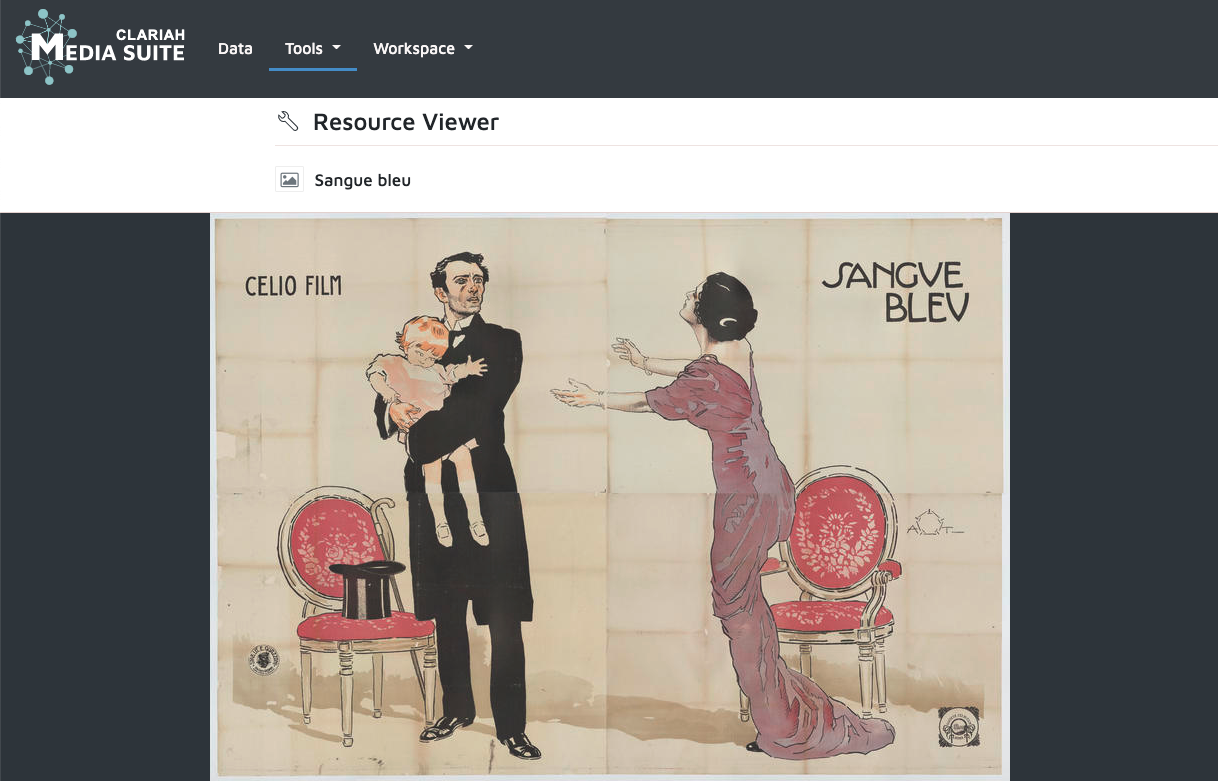
Now you are ready to move on to doing internal source criticism of the poster through a mini-visual analysis. When we reflect on internal aspects of a source, we think in terms of content features and form. This may mean analyzing features such as: text/image ratio, what is depicted in the image, what the relation between the text and the visual elements are and what function they have. If possible you may also try to do a mini-discourse analysis of the visual and textual elements.
-
To carry out your visual analysis of the poster you may add additional comments to the item using the “Comment” annotation functionality.
-
In relation to the Sangue Bleu it might be relevant to consider the following aspects and questions based on the points mentioned above: what type of situation does the poster depict? Is it for instance a peaceful or a dramatic situation? How do the characters in the image relate to each other? Does there seem to be a power relation between the characters? How are the characters dressed and what may this say about the milieu the situation takes place in? What role does the text play in (relation to) the image and what seems to be more important, the text or the visual elements? Of course, you may also think of many other aspects with regard to the visual composition, features or contents of the poster. These are just some suggestions to get you started.
-
Ultimately, your visual analysis of the poster should result in source critical considerations that also reflect on the historical viewers of the poster. Based on your visual analysis, what may you for instance say about how the poster addresses its viewers and what may you infer about the viewers’ reference frame or background knowledge?
6. Find, select and bookmark business documents with Search tool Desmet Paper Collection
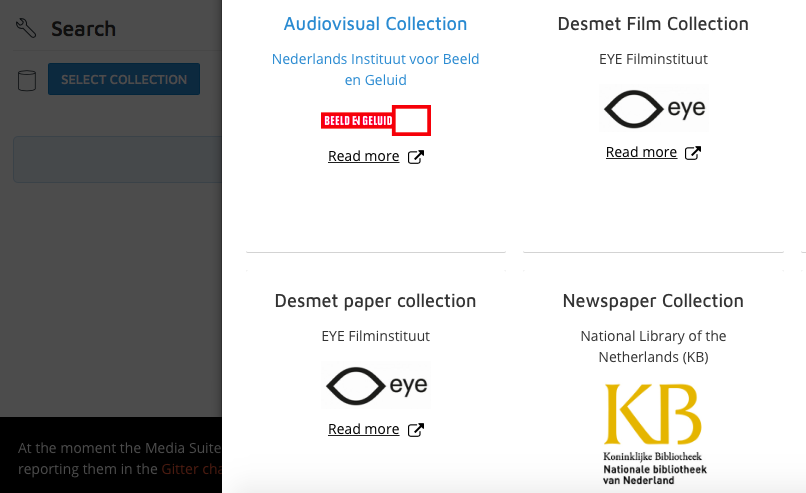
Now you have taken the first steps towards carrying out a source critical analysis on both an external and internal level of the Sangue Bleu poster. However, there are many other sources available in the Media Suite through which we may gain a better understanding of Sangue Bleu ’s acquisition, distribution and promotion history in the Netherlands. In this regard the sources kept in Desmet’s business archive are particularly interesting. Let us dive into this resource and see what we can find!
-
In order to search and add items from the Desmet Paper Collection to your corpus, you need to go back to the Search tool and now select the Desmet Paper Collection. To do so, hover over the “Tools” tab and select “Search” from the drop-down menu.
-
Again, make sure to set the active project in the upper left corner and make sure you choose the project you created in the beginning
-
Click “Select Collection” in the upper left corner and select “Desmet Paper Collection” from the drop-down menu (see image above for an illustration of how this should look like)
-
Now you can search in the Desmet Paper Collection containing the business archive of Jean Desmet. Try to find documents relating to Sangue Bleu by searching for keywords relating to the film. You may start by searching for some of the keywords related to the poster, for instance the film’s production company Celio Film, the film’s director Nino Oxilia, the film’s famous actress Francesca Bertini, or the Dutch title De Vorstin
-
You may also consider using Boolean query operators such as: AND, OR, NOT, Asterisk, Parentheses, Quotation Marks so as to combine keywords into one query and make your search more targeted. An example of such a query could be “Celio AND Vorstin” which combines the name of the production company and the Dutch title. If you need an introduction to the use of Boolean operators, you may consult the Media Suite Boolean query how-to guide which can be accessed via this link: https://bit.ly/2WLTWOK
-
Take a moment to reflect on the results you get: what keywords and combinations seem to work well? Are there things you had hoped to find but did not find, or keywords that give less results than you had hoped?
-
After having reflected on the process of searching the collection take a moment to bookmark a couple of items that you find relevant and want to take a closer look at. Choose one of these items for further source critical analysis at a later stage after having completed this tutorial, in addition to the item discussed in the next step.
7. Annotating reflections external source criticism of a business document
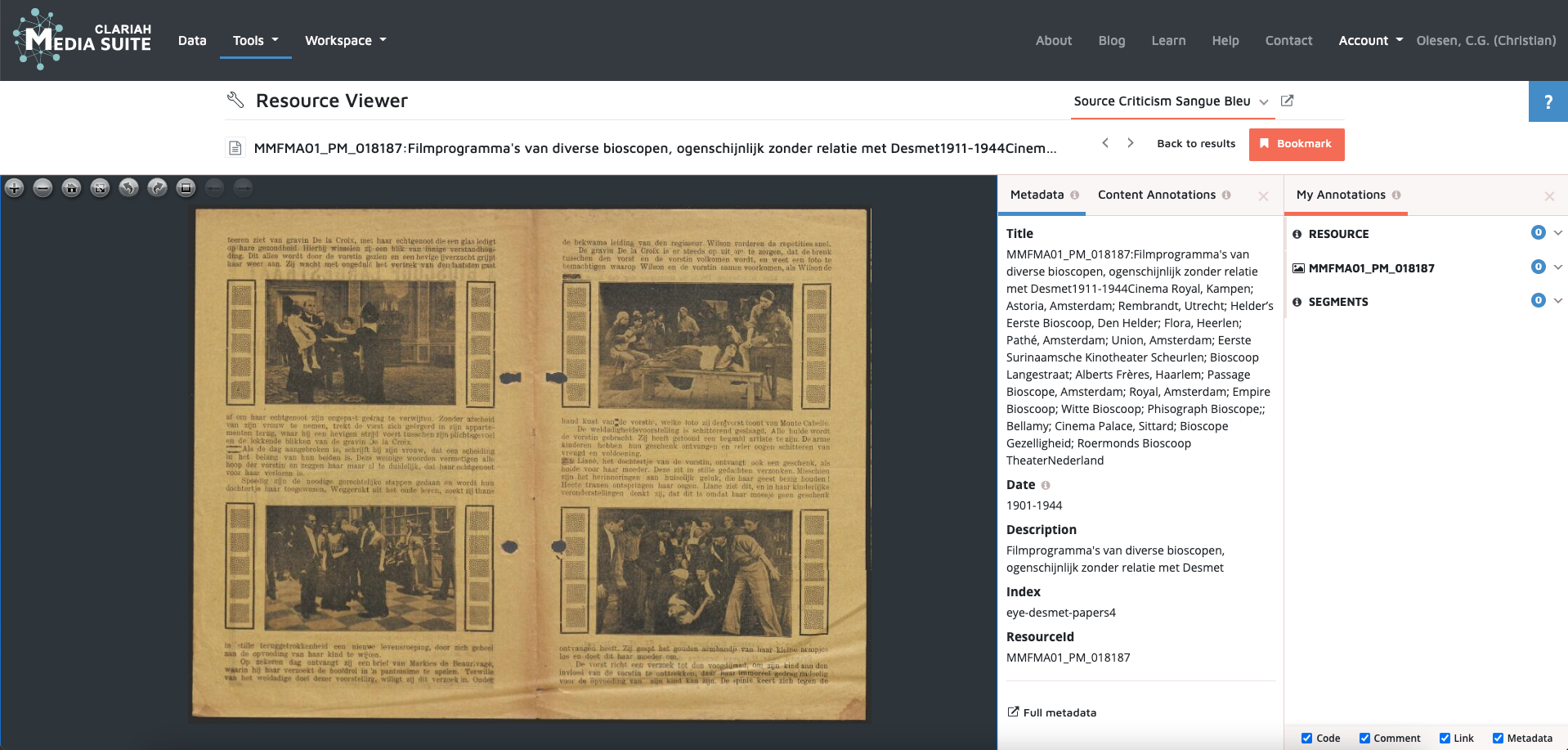
-
For this step we chose a film program that includes several stills from Sangue Bleu (item number MMFMA01_PM_018187). The program contains an elaborate explanation of the film’s plot supported by stills from the film. We found this item based on the search term “Vorstin” which matched a word in the text accompanying the pictures (this text has been automatically transcribed using OCR and can therefore be searched)
-
Now let us consider what type of source this is on an external level and what may be relevant to write down in a “Comment” annotation on resource level.
-
In the metadata next to the image on the right hand side the Eye Filmmuseum’s metadata for this item (in Dutch) is available and it tells us several interesting things about this item. First of all it tells us that this program comes from a cinema which did not necessarily have a relation to Jean Desmet. This may mean that the program was likely not made for one of Desmet’s own cinemas, but that it probably could have come from a cinema that he may have distributed the film to in one of the many cities listed in the metadata. Ultimately, we cannot say based on this data which cinema and city this concerns, but we may infer that Desmet wanted to keep this program in his own archive, for example as a way to get a sense of the film’s promotion in connection to its screenings. This observation would be relevant to put in an annotation. In order to be able to determine which cinema this concerned we could search further in the business archive, where there are also many documents pertaining to the acquisition and distribution of this film - for instance we might find a bill for a screening at one of the cinemas listed in the metadata in connection to this item.
-
Again, this is just one example, you may try to make a similar reflection or ask other questions with regard to the external features of the item you chose for this step and add a comment to it in order to save your observations for a later stage.
8. Visual analysis and annotating reflections internal source criticism Desmet business documents
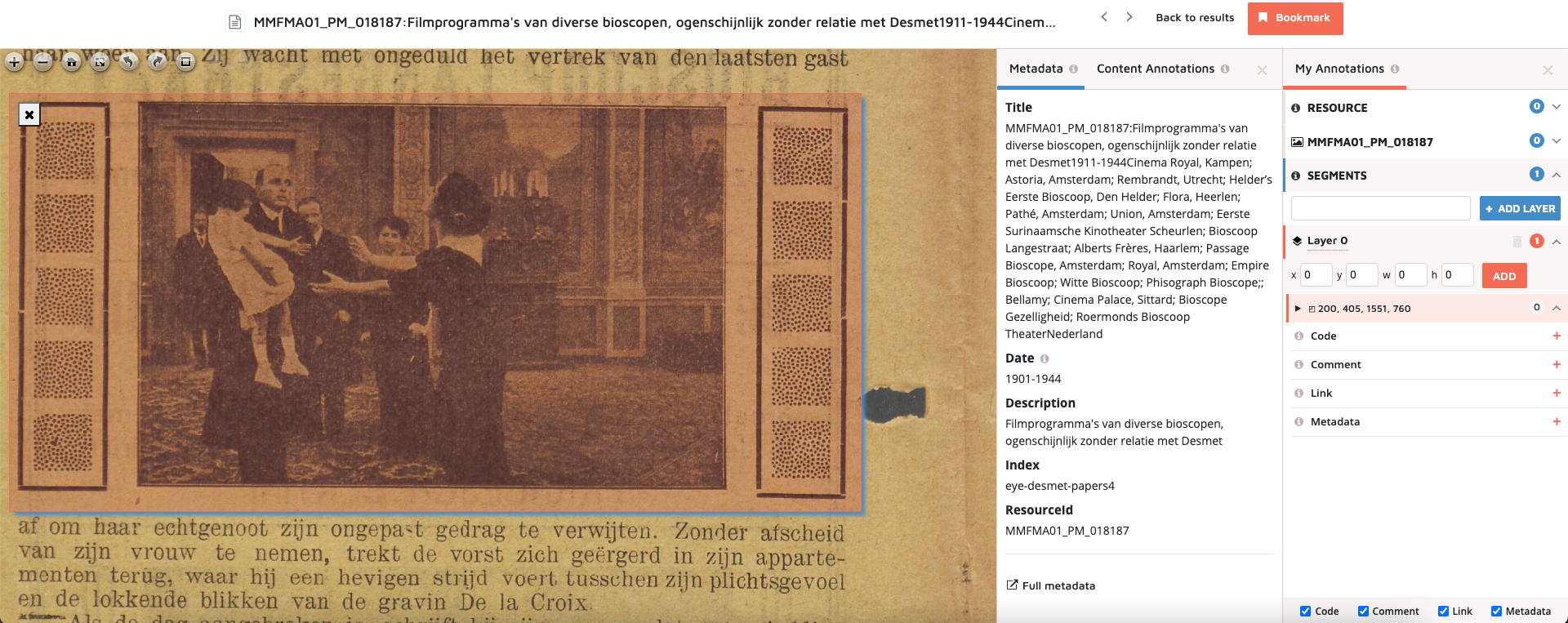
-
Having now considered some of the external features of the source, let us move on to the source’s internal level.
-
Different from the Poster Collection, Desmet’s Paper archive is embedded in the Media Suite in such a way that you can zoom in on the documents in high resolution, and create and annotate image segments as a basis for analyzing visual elements of the digitized documents on a detailed level. This feature lends itself particularly well to a visual content analysis of the documents and to source criticism at an internal level.
-
In terms of visual content, one of the things we immediately found striking in the chosen item was that there is a strong visual similarity to the poster. Just as in the poster, we see the actress Francesca Bertini standing in the exact same pose from the back reaching out to a child held by a man. This suggests a relation between the two items and also seems to highlight the preference for this particular motif in the promotional material.
-
However, we also observe that the man does not seem be the same as on the poster - judging from thet hair cut at least he is styled or framed quite differently than on the poster. Moreover, the mise-en-scene of the poster - in particular the two chairs - is also not the same as on the image in the program. This is interesting insofar as the two images seem to highlight a similar dramatic moment and establish a similar visual discourse without however depicting the exact same situations. It seems then, that the program image’s emphasis addresses the readership in a way similar to the poster while not playing as freely with visual elements from the film as in the poster. In this sense, the still and the poster are evidently different types of sources with different relations to the film.
-
Though far from exhaustive - ideally we should also take a much closer look at the text and the other images of this program page - this is an interesting first observation that would be useful to connect to the item through annotation. It is possible to do this by singling out different segments in the image and subsequently annotate them.
-
In order to create a segment in the image press the square symbol appearing in the image viewer’s toolbar in the upper left corner - this symbol stands for “Toggle selection” - and subsequently define a region of the image you wish to select
-
Once you have defined a region press the check mark symbol in the selection to confirm that you wish to save it as a segment. The segment now appears as a layer in the “SEGMENTS” overview of the “My Annotations” column.
-
To view this layer, click on the Layer tab and subsequently on the segment you just created. A drop-down menu appears with the same annotation options as on resource level - “Code”, “Comment”, “Link”, “Metadata” - (see the image above for an example of what this should look like). Click on the “Comment” tab and add your observations to the item.
9. Searching De Bioscoop-Courant in Eye Filmmuseum’s online library

Now we have looked at items from Jean Desmet’s poster and business archive from a source critical perspective in order to take some first, small steps towards gaining a better understanding of Sangue Bleu ’s promotional history and distribution. Until now, we have only looked at documents that are preserved in the Desmet collection. Yet, there are several other resources that are not embedded in the Media Suite that may be relevant to consider in relation to items in the Desmet collection and that may offer additional context. For instance, the Eye Filmmuseum’s library has digitized several historical journals that could be of interest in this regard (a list of digitized journals in Eye’s library can be accessed here ). De Bioscoop-Courant is one such journal. This trade journal was published between 1912-1920 and partly covered the years in which Desmet was active as a cinema distributor. We know that Desmet advertised his films to cinema owners in this journal, including advertising for Sangue Bleu (Blom, 2000). Let us now step outside of the Media Suite and see what we can find out about Sangue Bleu through this resource via Eye Filmmuseum’s database.
-
In order to find De Bioscoop-Courant in Eye’s library first go to Eye’s online library via this address: http://bibliotheek.eyefilm.nl/
-
Once you have arrived in the library search interface type “De bioscoop courant” in the search field. This should give you somewhere between 445-450 results depending on whether you search with or without quotation marks.
-
When you scroll down the list of results you will notice that you can click on links to individual issues of De Bioscoop-Courant under the header “Document”. Through these links you can access the pdfs (when available) of the scanned journal issues.
-
On the right hand side you can filter based on year, which allows you to narrow down your search to specific volumes of the journal. Sangue Bleu is from 1914, so let us try to narrow our search down to the 1914-1915 volume using the year filter. This should result in a list of four issues under the header “Onderliggende document”, all available in pdf.
-
Click through the pdfs to see if you can find any materials on Sangue Ble u / De Vorstin . Once you have found something proceed to the next step.
10. Linking items in the Media Suite to De Bioscoop-Courant
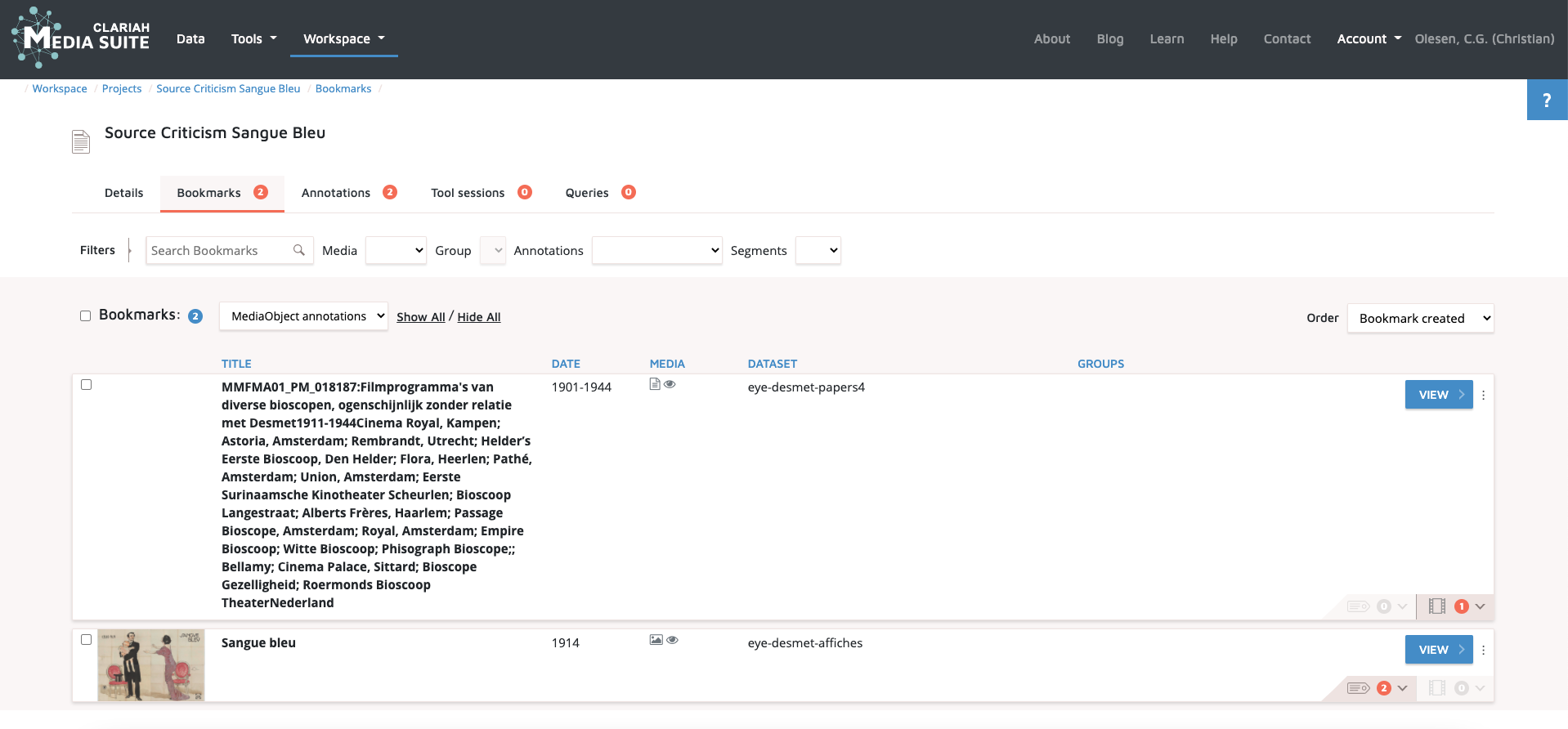
-
There was indeed something to be found in De Bioscoop-Courant. Issue number 42 from 1915 contains a two-page advertisement placed in the journal by Desmet, next to another advertisement for a film - Filibus (Italy, 1915) - also distributed by Desmet.
-
Because this may be an interesting find for understanding the film’s promotion you may want to connect this document to the sources you have entered to your corpus in the Media Suite before analyzing it. You can do this through an annotation.
-
In order to do so go back to your project in the Media Suite. In the Media Suite click on the “Workspace”-tab, then on “User Projects” and select your project. In the project overview click on the “Bookmarks”-tab which will direct you to an overview of the items in your corpus (see image above for an example of what this overview should look like). Choose one of the items you want to link to the pdf of the issue of De Bioscoop-Courant, for instance the poster, and view it in the resource viewer.
-
In the annotation bar on the right-hand side you can now enter a link (use the link from the PDF viewer) to the journal issue as a comment on resource level or as a custom link under the “Link” annotation tab. This makes it easier to find and connect the items at a later stage in your research, if necessary.
11. Annotating external and internal source critical reflections on Sangue Bleu advertisement in De Bioscoop-Courant
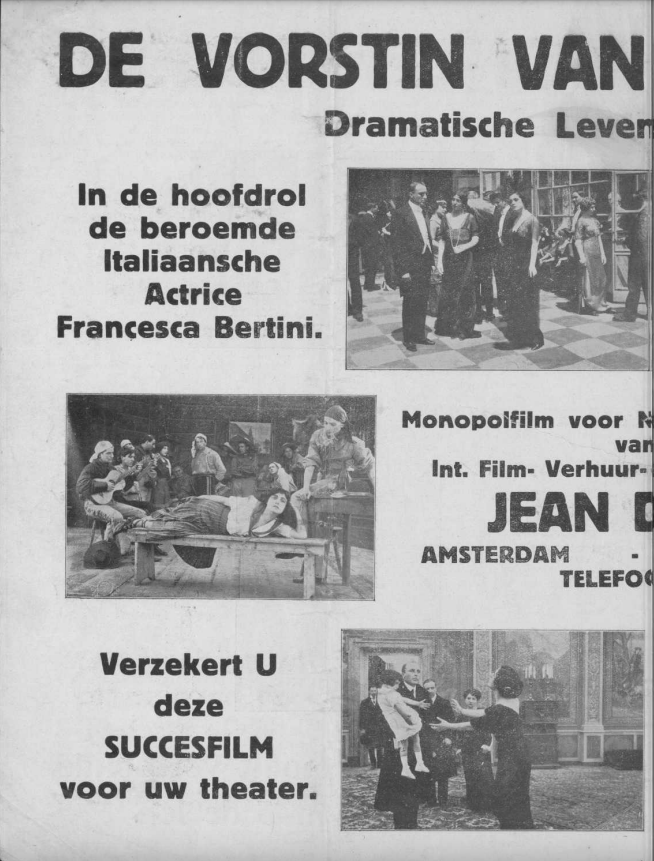
-
Now let us get back to De Bioscoop-Courant and consider how we may approach this material from a source critical perspective.
-
On the external level we could first reflect on who this source is made by and for. Begin by considering the issue as a whole. From looking through the issue what can you infer about its function and reliability? Who published this trade journal and who read it? These are fundamental questions we would advise you to start with.
-
Now take a closer look at the source on an internal level. Try to read through some of the text of the issue. What strikes you about it? How would you characterize the texts in it - what are the topics of the text and what kind of language is the text written in, specialized or accessible? May you infer something about the readership of the journal and the readership’s language register based on the text?
-
Now let us consider the advertisement for Sangue Bleu . What are the differences between the poster, the program page saved by Desmet and the advertisement in De Bioscoop-Courant? What is the ratio between text and image in this advertisement (see image above) and what is mentioned in the text? Why do you think that certain names are mentioned in this advertisement, and why may these not be mentioned on the poster? Could there have been materials related to the poster that you did not have access to or are these really two very different ways of promoting the film visually? Of course, there are also striking visual similarities between all of these three sources to be noticed - what may that tell you about the visual discourse of film promotion at the time and for instance the role of film stills in it?
-
These are just some of the questions you may consider for a start. Try to come up with more questions yourself and make sure to add your reflections as annotations in the Media Suite so you can go back to them at a later stage.
12. Accessing annotations in the Workspace
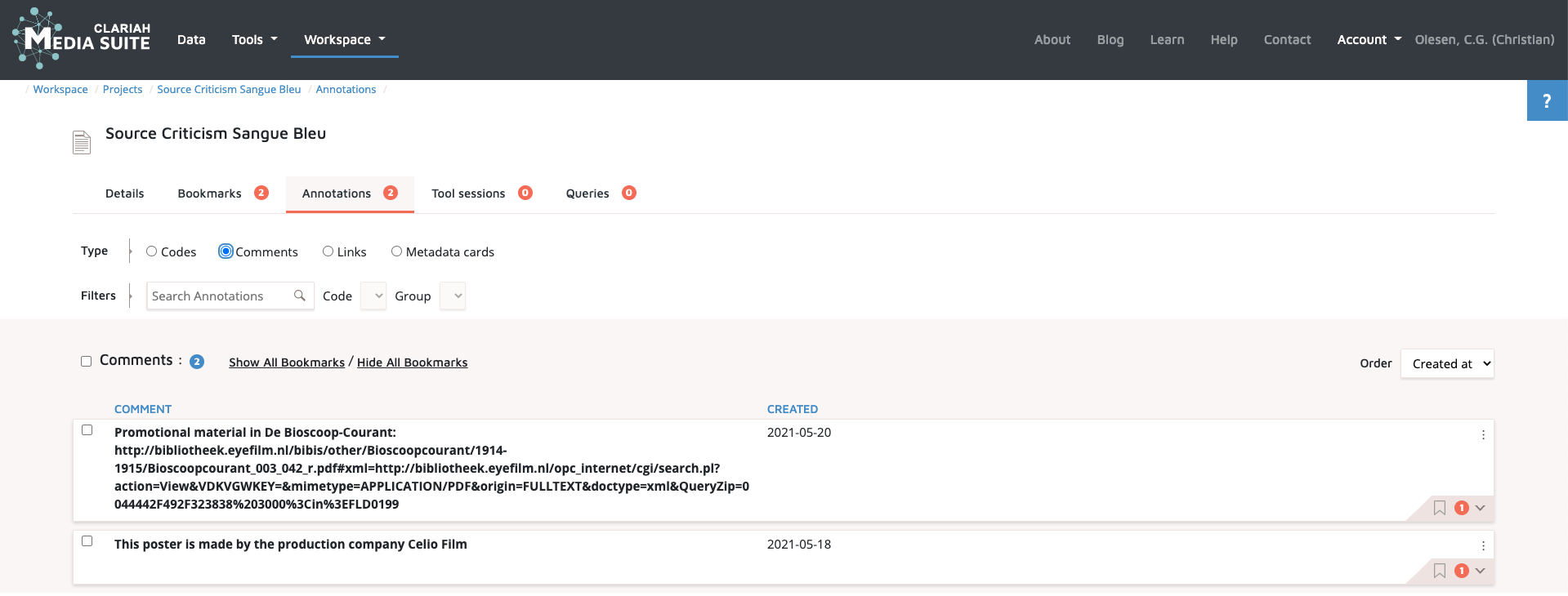
-
As you add more annotations to the items, it is good to know that you can access all your annotations in the Workspace environment at a later stage, for instance as a basis for writing a paper or giving a presentation based on your research.
-
To access an overview of all your annotations go back to your Workspace and click the “Annotations”-tab. Then click on the type of annotation you wish to see an overview of (“Codes”, “Comments”, “Links”, “Metadata cards”) after which an overview of the selected type of annotations will appear.
-
Now you have learned to add source critical reflections as annotations to items in the Jean Desmet Collection in the Media Suite and to link items in the Media Suite to digitized resources in Eye Filmmuseum’s library. Well done!